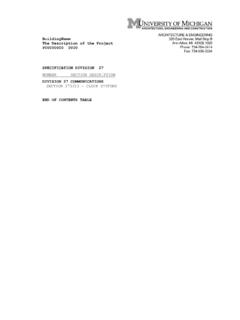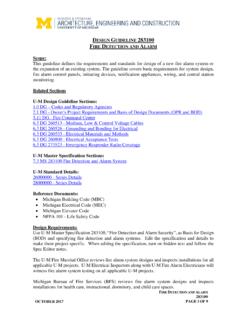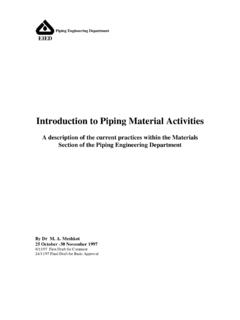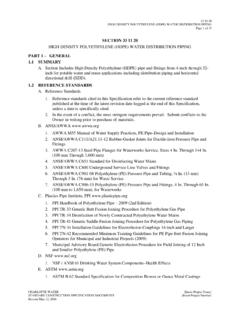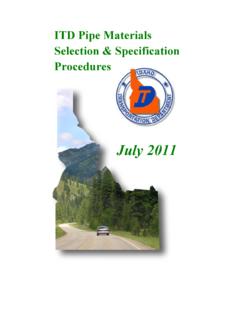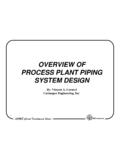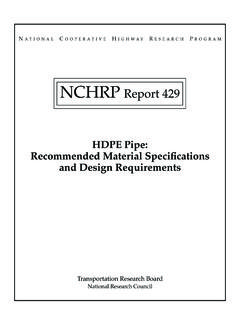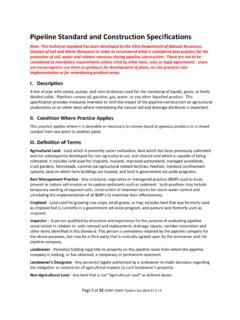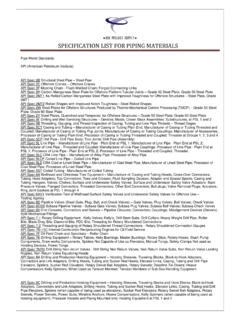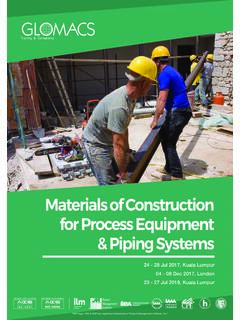Transcription of BASIC PIPING MATERIALS AND METHODS
1 15060 BASIC PIPING MATERIALS AND METHODS 15060 SEPTEMBER 2012 PAGE 1 OF 7 BASIC PIPING MATERIALS AND METHODS General In general, follow the guidelines below when designing and specifying pipe, pipe fittings, and accessories. Unless specifically indicated otherwise, these guidelines are not intended to restrict or replace professional judgment. PIPING MATERIALS shall be compatible with systems served. Related Sections U-M Design Guideline Technical Sections: Division 2 - Sitework 15250 - Mechanical Insulation 15300 - Fire Protection Systems 15460 - High Purity Water Systems U-M Master specification : Division 2 - Sitework 15010 - BASIC Mechanical Requirements 15011 - Mechanical Submittals 15060 - BASIC PIPING MATERIALS and METHODS 15070 - Underground PIPING in Conduit System 15071 - Underground Chilled Water PIPING System 15300 - Fire Protection Systems 15515 - Hydronic Systems and Specialties 15525 - Steam Systems and Specialties 15530 - Refrigerant PIPING U-M Standard Details, Schedules and Tables.
2 15060 - PIPING System Pressure Test Table Design Phase Deliverables General material Requirements Refer to U-M Master specification for PIPING and accessory MATERIALS and installation requirements, including: Drainage and Vent PIPING , Pressurized Plumbing PIPING , Hydronic and Steam PIPING , Eccentric Fittings, Tees in Welded Pipe, Solder in Copper PIPING Joints, Dielectric Protection, Flanges, and Unions previously addressed in this section. In all cases, pipe MATERIALS and accessories must be compatible with systems served (pressure, temperature, corrosion resistance). Master specifications contain extensive hidden text for the specification editor to guide decision making process. Where U-M Master Specifications are used, edit and customize on a project specific basis. Note that only the more typical PIPING applications are covered in the U-M master specification ; assure every pipe application specific to the project is specified.
3 Additional clarification is included in paragraphs that follow. 15060 BASIC PIPING MATERIALS AND METHODS 15060 SEPTEMBER 2012 PAGE 2 OF 7 PIPING Accessories material Requirements Ductile Iron Pressure Pipe Inside Buildings In all cases, ductile iron pressure pipe running inside buildings shall be equipped with retrained joints. This includes new construction and renovation work. Ductile iron pressure pipe should normally not be run inside buildings. A typical case when this is unavoidable is underground domestic, fire protection, or chilled water ductile iron pipe connecting to the associated building PIPING system. The transition between the underground ductile iron pressure pipe and the building pipe shall be accomplished with a flange located inside the building. For new installations, specify that the termination of the ductile iron pipe (and any ductile iron joint inside the building) be factory threaded and equipped with a screw-on, machine tightened, ductile iron flange that complies with ANSI/AWWA C110 and C115, similar to that available from American Ductile Iron Pipe, US Pipe, and others.
4 For existing buildings with unrestrained plain end or mechanical joint ductile iron PIPING , replace with restrained flange adapters with actuating screws that break off when tightened to the proper torque, such as EBAA Iron Incorporated MEGAFLANGE Series 2100. Do not specify restrained flange adapters that do not incorporate break-off actuating screws. Pipe Penetrations and Sleeves Provide pipe sleeves where required, including the following locations: Where required by code Where required as part of rated penetration, to maintain fire and smoke rating To support vertical PIPING (to support riser clamps). Where required to maintain water seal and prevent water penetration. Where pipe movement is anticipated (especially due to thermal expansion) at the penetration. Fire Protection PIPING , Compressed Air and other uninsulated PIPING : Sleeves are generally not required, unless required to maintain integrity of rated walls.
5 Chilled Water and Cold Water: Sleeves are generally required for all PIPING 2" and larger penetrating walls and floors. Steam, Condensate, Heating Hot Water, and other hot insulated PIPING : Sleeves are required for all PIPING in walls and floors. For underground exterior wall penetrations, PIPING penetrations must be watertight. For new construction, provide cast-in-place pipe sleeve with integral water-stop, oversized for use of 15060 BASIC PIPING MATERIALS AND METHODS 15060 SEPTEMBER 2012 PAGE 3 OF 7 linkseal between PIPING and sleeve. In existing concrete, where concrete can be core drilled and properly sealed with a linkseal, a sleeve may not be required. For renovation work with existing concrete floors or for new floors where cast-in-place sleeves were not installed, pipes penetrating above grade floors typically require double core sleeves, especially in areas where floors are likely to get wet, and where water leaks to floors below would be disruptive to operations.
6 PIPING in stairwells does not require floor sleeves. Include appropriate, project specific penetration and sleeve details for all conditions. Refer to U-M details, and customize as required. Pipe Hangers and Supports Refer to U-M Standard Details, U-M Master specification 15010 and 15011 for additional hanger and support requirements previously addressed in Design Guideline Section 15140. Refer to Design Guideline Section 15010 for building attachment requirements previously included in this section. The A/E shall include the following in PIPING designs: Pipe hanger details, including components, hanger spacing. Pipe hanger systems that accounts for thermal expansion of PIPING . Details of building attachments, including clarifying when support of PIPING from concrete slab using expansion anchors is acceptable.
7 "C" type clamp hangers are acceptable for fire protection PIPING and all PIPING 2" and smaller when retaining clips are used. For large PIPING or where the design otherwise impacts the integrity of the building structure, indicate locations of all pipe hangers. For existing buildings with concrete floors, determine the extent to which vertical drill-in or similar type inserts can be used, and delineate any limitations regarding their use in the specifications. Many older buildings may not have sufficient floor thickness or integrity to allow the use of such inserts. Indicate locations and details of pipe anchors, guides and expansion joints or bends. Dissimilar metal-to-metal contact between pipe and hanger is prohibited. Hangers for PIPING that lacks rigidity, such as polypropylene pipe, shall be spaced, as a minimum, as recommended by the manufacturer or preferably, with a continuous support.
8 Since the spacing is typically much closer than for other PIPING MATERIALS , the designer must pay close attention to the implications on the design. 15060 BASIC PIPING MATERIALS AND METHODS 15060 SEPTEMBER 2012 PAGE 4 OF 7 For cold PIPING systems, design PIPING hangers to retain integrity of vapor barriers. Specify cal-sil or similar pre-formed inserts and insulation shields for all PIPING 4" to 12" requiring a vapor barrier (wood blocking is not acceptable). Insulation shields are acceptable for PIPING 3" and below. Design for Thermal Expansion: Account for thermal expansion when designing pipe hangers and supports. Where space allows, expansion bends fabricated from standard PIPING are preferred over expansion joints. Within steam tunnels, and up to building shut off valve, for LPS and medium pressure steam (MPS) design expansion for 600 F maximum PIPING temperature.
9 MATERIALS do not need to withstand 600 F at associated saturated pressure. For steam tunnels, on low pressure steam (LPS), externally pressurized bellows type expansion joint shall be used. For low pressure condensate (LPC), use externally pressurized bellows type expansion joint or equal expansion bellows type expansion joint. For domestic hot water (DHW), use equal expansion type bellows joints with all Stainless steel construction (no carbon steel on wetted parts). Refer to U-M Master specification 15125 Expansion Joints. Mechanical PIPING Requirements Refer to U-M Master specification Sections for details of PIPING material requirements. Clarifications and exceptions are noted below. Domestic Cold Water and Hot Water Domestic Hot Water PIPING installed in the central campus tunnel system shall use exclusively Victaulic grooved copper pipe and fittings.
10 Storm and Sanitary Waste and Vent PIPING Vent PIPING shall be the same as waste PIPING . Master specification includes both cast iron and PVC PIPING . Use cast iron unless specifically instructed by U-M Design Manager to use PVC. While PVC may have some appropriate applications in small projects, there can be smoke/fire related problems with using PVC. Laboratory Waste and Vent PIPING For most chemistry and biology labs, dumping of acids and other corrosive chemicals is prohibited. As such the waste stream is generally dilute, within Ph limits suitable for discharge to city sanitary sewers. Therefore, in most cases, neutralization pits are not required. Confirm design philosophy on lab waste system with U-M Design Manager. For general lab applications, above ground lab waste PIPING is typically specified as corrosion resistant polypropylene, Schedule 40.


